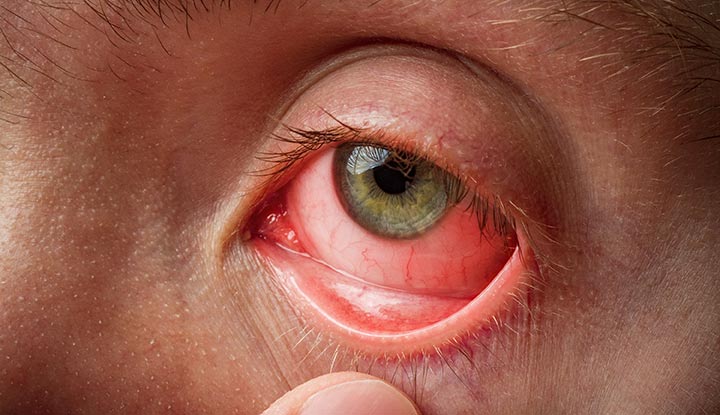Conjunctivitis
Conjunctivitis, also called pink eye, is an inflammation of the conjunctiva. Well, the conjunctiva itself is a clear membrane that covers the white part of the eye (sclera) and the inside of the eyelids. This inflammatory disorder of the conjunctiva can cause the white part of the eye to appear reddish or pink.
This eye disease is usually caused by bacterial or viral infections, to allergic reactions. Even so, this disorder rarely affects vision. In addition, conjunctivitis most often attacks children, because this eye disease can spread quickly in schools and daycare centers.
However, conjunctivitis is rarely serious, especially if it is found and treated quickly. The role of parents is very important to address this problem in children quickly so that the discomfort caused can be overcome immediately.
Symptoms of Conjunctivitis
Symptoms of conjunctivitis vary depending on the type and cause. In general, the symptoms of conjunctivitis are:
- Red eyes in one or both eyes.
- The eyes also often feel itchy and like there is sand in them.
- The eyes can produce a thick, crusty discharge at night, making it difficult to open your eyes in the morning.
- Enlarged lymph nodes may also be found.
- Eyes feel burning and/or sore.
- Swollen eyelids.
- Blurred vision.
- Eyes are sensitive to light.
- Green or white discharge from the eyes.
Risk Factors for Conjunctivitis
There are several factors that increase a person’s risk of experiencing this eye problem, including:
- Using contact lenses, especially long-term wear.
- Exposure to someone infected with the virus or bacteria causes this eye disorder.
- Being exposed to something that causes a person to be allergic.
Causes of Conjunctivitis
As mentioned earlier, there are three main types that cause this eye disorder, namely infections from viruses or bacteria, and allergies. However, there are several other causes that can cause conjunctivitis, such as:
- Reaction to eye drops.
- Irritants to shampoo, dirt, smoke, and chlorine.
- Fungi, amoeba, and parasites.
Conjunctivitis is also sometimes caused by sexually transmitted diseases (STDs). Gonorrhea and Chlamydia are examples of STDs that can cause conjunctivitis.
Types of Conjunctivitis
There are several types of conjunctivitis that are distinguished by their causes. Here is a more complete explanation:
-
Viral Conjunctivitis
This viral eye condition is the most common type of conjunctivitis. This type of pink eye is highly contagious and often spreads in certain settings, such as schools and other crowded places. This condition can cause burning red eyes with discharge.
-
Bacterial Conjunctivitis
This eye problem is also considered very contagious. A bacterial infection causes the eyes to turn pink. This disorder can also cause pain in the eyes with lots of sticky pus in the eyes. Some bacterial infections can also cause little or no discharge.
-
Allergic Conjunctivitis
This eye problem is caused by an allergic reaction to pollen, animals, cigarette smoke, pool chlorine, car exhaust, and many more. This conjunctivitis is not contagious. When it occurs, you can feel very itchy, red, and watery, and the eyelids can become swollen.
Diagnosis of Conjunctivitis
To make a diagnosis, the doctor will initially ask questions about symptoms and recent medical history related to conjunctivitis. After that, supporting examinations are carried out by taking samples of fluid flowing from the eye to be analyzed in the laboratory (culture).
This laboratory examination can help the doctor to determine the cause of the disorder. For example, caused by bacteria, viruses, allergies, or other problems. After that, the determination for the right treatment can be done.
Conjunctivitis Treatment
Treatment for this eye disorder depends on the underlying cause. Here are some treatments:
- For viral conjunctivitis, doctors will not prescribe antibiotics, as it usually resolves on its own within one to three weeks. To create more comfort, apply a cool, wet cloth to the eyes.
- Bacterial conjunctivitis can be treated with antibiotic eye drops or ointment. However, if the conjunctivitis is caused by gonorrhea or chlamydia, oral antibiotics are needed.
- Allergic conjunctivitis can be treated with vasoconstrictors, antihistamines, and steroid eye drops. This can help relieve itching and swelling.
General treatment is symptomatic for all types of conjunctivitis, namely compressing the eyes with warm water for 5-10 minutes 4 times a day to relieve discomfort. In addition, artificial tears can also be given. For conjunctivitis sufferers who use contact lenses, it is recommended not to wear contact lenses until the eyes are completely healed.
Complications of Conjunctivitis
If left untreated, conjunctivitis can cause complications in the form of inflammation of the cornea that affects vision. This can happen to both children and adults. Therefore, proper evaluation and treatment are needed to avoid problems such as blurred vision or light sensitivity so that the risk of complications is smaller.
Conjunctivitis Prevention
Here are some ways you can do to prevent conjunctivitis:
- Keep your hands clean and do not touch your eyes with your hands.
- Wash your hands more often.
- Use clean towels and cloths every day.
- Do not share towels or washcloths.
- Change pillowcases as often as possible.
- Limit the use of eye cosmetics, such as mascara.
- Do not share eye cosmetics or personal eye care items.
- Avoid allergy triggers.
- Clean contact lenses regularly, especially before use.
When to See a Doctor?
If you experience symptoms of conjunctivitis, such as eye pain, a feeling of something stuck in your eye, blurred vision, and light sensitivity, see an eye doctor immediately for treatment.
Those who wear contact lenses should stop wearing them as soon as symptoms of conjunctivitis begin. If symptoms do not improve within 12 to 24 hours, make an appointment with your eye doctor to make sure you do not have a more serious eye infection related to your contact lens use.
